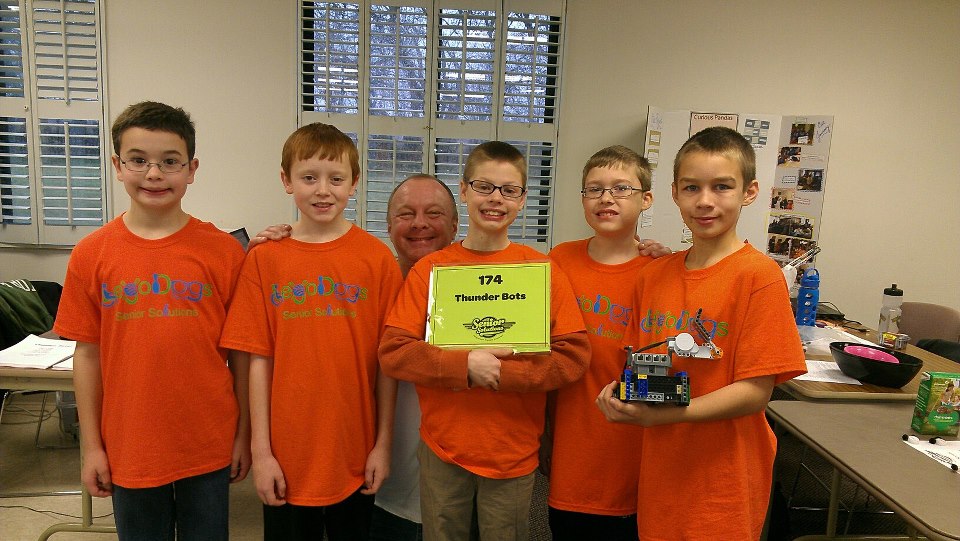 Pono is the 11-year-old son of a college friend and now well-respected physicist, Dr. Brendan Casey. A few months ago, Brendan asked if Pono could speak to me about a Lego Robotics project. Besides vacuuming my son’s Legos by the bagful, I don’t know much about them.
Pono is the 11-year-old son of a college friend and now well-respected physicist, Dr. Brendan Casey. A few months ago, Brendan asked if Pono could speak to me about a Lego Robotics project. Besides vacuuming my son’s Legos by the bagful, I don’t know much about them.
Pono and his friends were entering a FIRST LEGO League competition to build a robot that could assist older adults. FIRST LEGO League is “a robotics program for 9 to 16 year olds, which is designed to get children excited about science and technology -- and teach them valuable employment and life skills.”
The theme for the 2012 Lego Robotics competition was “Senior Solutions.” The challenge posed by the competition organizers was to improve the quality of life for seniors by helping them stay independent, engaged, and connected in their communities. Specifically, the teams in the Senior Solutions project were charged with finding a senior partner, identifying and learning about a problem faced by seniors, creating an innovative solution to the problem identified, and then sharing the problem and solution with others.
As I read more about the Lego Senior Solutions project, I was impressed—not only by the challenge itself, but by the thoughtful process and needs-driven, person-centered approach outlined for the teams. For example, the competition went beyond asking students to identify a problem and create an innovative solution, but also asked teams, “How can your solution help seniors feel respected and do the things they love?” Kudos, Legos!
To address the challenge, Pono and I spoke about common issues of older adults, specifically medication management. Numerous Institute of Medicine reports have documented the severity of this issue and we, therefore, know that medication errors are responsible for nearly 7,000 deaths annually in the U.S. and that the cost of drug-related illness and death exceeds $170 billion per year. Up to 48 percent of community-dwelling elders have medication-related problems. However, at least 25 percent of all adverse drug events caused by medication errors are preventable. (You can learn more about medication management issues for older adults from our grantee, Partners in Care Foundation.)
Pono and I also discussed the role of older adults and their caregivers in ensuring that people take the right medications at the right time. According to a September 2012 Hartford-funded AARP Public Policy Institute and United Hospital Fund survey of 1,677 caregivers, most care recipients take multiple medications: 46 percent take between five and nine prescriptions and nearly one in five (18 percent) take ten or more. This report, Home Alone: Family Caregivers Providing Complex Chronic Care, explores the complexity of tasks provided by the 42 million unpaid family caregivers in our country.
Notably, more than 80 percent of family caregivers help care recipients take oral medications by administering pills or preparing a pillbox for recipients to take independently. Family caregivers find medication management difficult and time-consuming. They expressed fear around making a mistake and causing harm (29 percent)—couple this with the fact that close to 60 percent of caregivers are giving five or more medications.
 L to R: John, Matt, Coach Brendan Casey, Jack, Nathan, and Pono
L to R: John, Matt, Coach Brendan Casey, Jack, Nathan, and PonoLearning about this, Pono and the 5-member FIRST LEGO League team (named Thunder-bots) created a Lego “robot medicine dispenser that puts out the correct medicine at the correct time using a color sensor and an alarm clock.” The robot sounds an alarm when it is time to take the medication and uses a sensor to point out which medication to take. The older adult then touches the sensor when they take the medication. If they don’t hit the sensor, it uses blue tooth technology to send a message to a doctor or a family member. Once a week, someone from Senior Services Associates comes and fills the robot up.
Here is the robot in action:
https://www.youtube.com/watch?feature=player_embedded&v=3bAaTDiy1I8
According to Pono, as part of the Senior Solutions project, other teams created some interesting innovations, including:
• A Swipeomatic card which an older adult can use to slow down traffic lights and doors.
• RoboArm2000, an arm that attaches to the back of a wheelchair to help seniors reach things.
• A floor sensor that turns the lights on when older adults get out of bed to prevent falls.
It is encouraging to see kids these days focused on creative solutions to real-world problems affecting a large segment of our society. Pono, who hopes to be a professional Lego Designer when he gets older, is looking forward to the state competition Jan 18-19, 2013.
What would he ultimately like to see come about as a result of his Lego Robot?
“The best research project in internationals gets money to get a patent for their design. That would be cool!!!!!”
Go Thunder-bots. Good luck this week! Victory or not, the Hartford Foundation will be singing your praises.
Till then, here is a song, “Memory Loss Blues,” which the Thunder-bots wrote and performed about their project:
Memory Loss Blues
We talked to our grandparents
They listed their problems
The lists were all really long
But they had one thing in common
Memory loss…………. Memory loss blues
We talked to Rachel Watman
At the Hartford Foundation
She said memory loss
makes people forget to take their medication
She said even worse
Sometimes they take the wrong medication
And when people take the wrong medication
7000 people die each year in this nation
Memory loss…………. Memory loss blues
We learned a lot in robotics
We learned to make a robot make a sound
We learned to use a color sensor
In the mission where the green bottle needs to be found
We created a robot
To help seniors with their medication
We know our robot
Will help to end senior’s frustration
Memory loss…………. Memory loss blues
We talked to Rachel Watman
and told her about our bot
She said she thought
It was really really hot
Rachael said if they didn’t take the meds
the robot should send an alarm
To make sure the seniors
don’t come to any harm
Memory loss…………. Memory loss blues
The Recora Company,
Mike Wempe is the head
He taught us to build sensors
That alarm when people get out of bed
We built his sensor
And put it in front of our bot
Then we could know
If they took the meds or not
Memory loss…………. Memory loss blues
We learned in robotics
To turn Bluetooth off
But for our project
It’s just what we want
It can tell doctors or family members
If the sensor doesn’t sound
The medication
the seniors haven’t found
Memory loss…………. Memory loss blues
We found a problem
Who would fill the meds
We talked to Micki Miller
From Senior Services Associates
They work for the State
They help seniors out
They could fill up the robot
When the meds run out
We cured the blues………….. Memory loss blues
